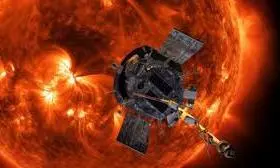
Parker Solar Probe achieves record-breaking Sun approach
text_fieldsNASA's Parker Solar Probe has set a new benchmark in space exploration by completing its closest approach to the Sun.
On December 24, 2024, the spacecraft came within 3.8 million miles of the solar surface, traveling at an unprecedented speed of 430,000 miles per hour - the fastest velocity ever reached by a human-made object. A beacon signal received on December 26 confirmed the probe's successful operation after the historic flyby.
The Parker Solar Probe's achievement represents a major step forward in solar research. This closest approach is the first of many planned at this record distance, made possible by the spacecraft's carefully optimized trajectory. Since its launch in 2018, the probe has utilised seven Venus flybys, the latest occurring on November 6, 2024, to refine its orbit and withstand the Sun's extreme environment.
Equipped with a robust carbon foam heat shield capable of withstanding temperatures up to 1,800 degrees Fahrenheit, the probe protects its sensitive instruments, ensuring their functionality during close passes of the Sun. John Wirzburger, mission systems engineer at Johns Hopkins Applied Physics Laboratory, underscored the decades of technological innovation necessary to achieve this mission.
NASA Associate Administrator Nicky Fox emphasized the significance of the mission for advancing our understanding of solar phenomena and their influence throughout the solar system. Data gathered by the Parker Solar Probe is expected to provide new insights into the acceleration of solar wind and the behavior of energetic particles in proximity to the Sun.
The spacecraft has already contributed to groundbreaking discoveries, including mapping the solar atmosphere's structure and identifying the origins of solar wind switchbacks. Future data transmissions from this latest flyby will deepen understanding of these processes and contribute to transformative advancements in solar science.
The mission’s trajectory includes additional close approaches scheduled for March 22 and June 19, 2025, promising further discoveries.























